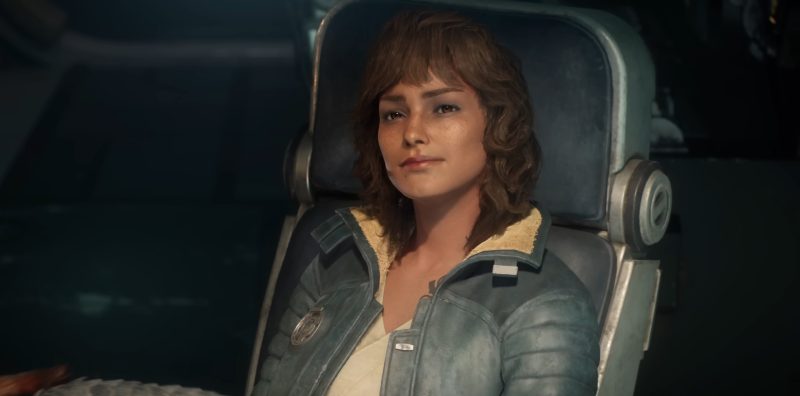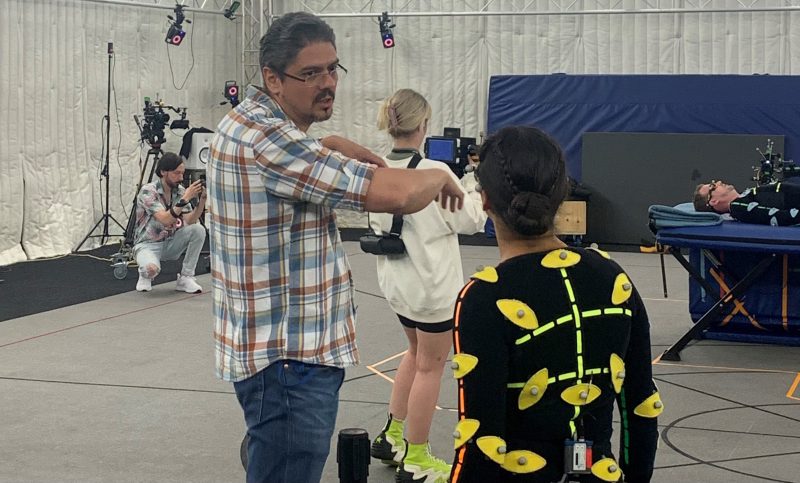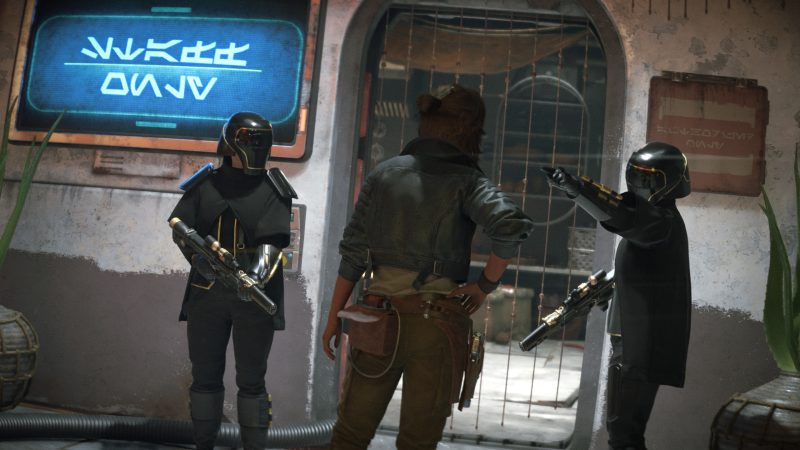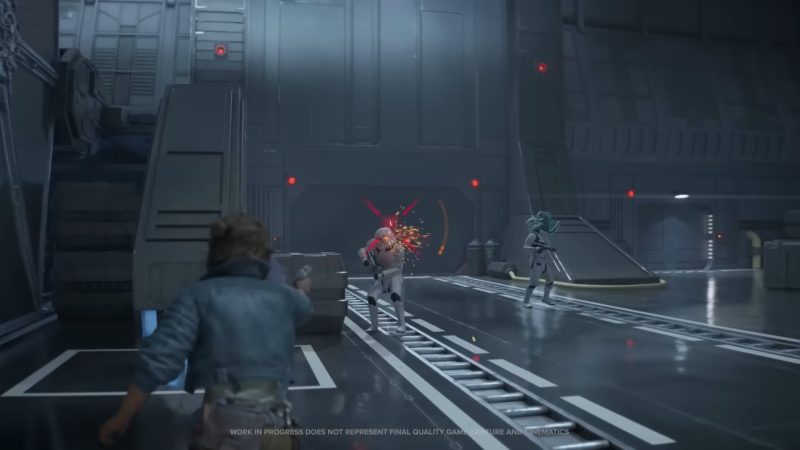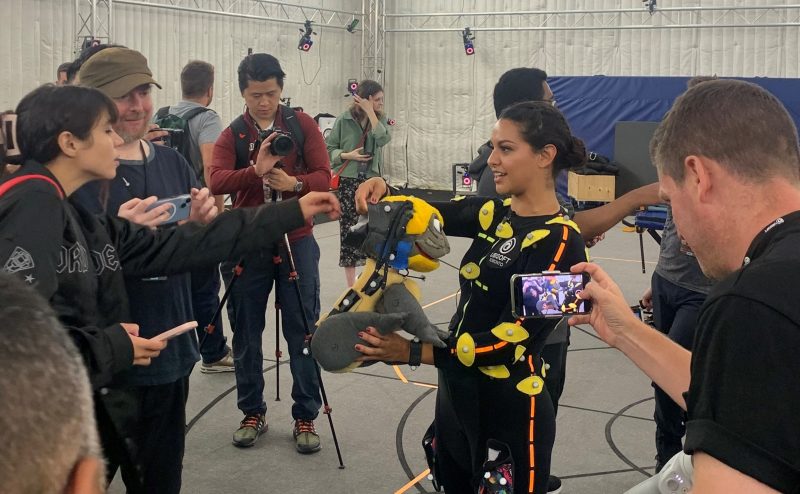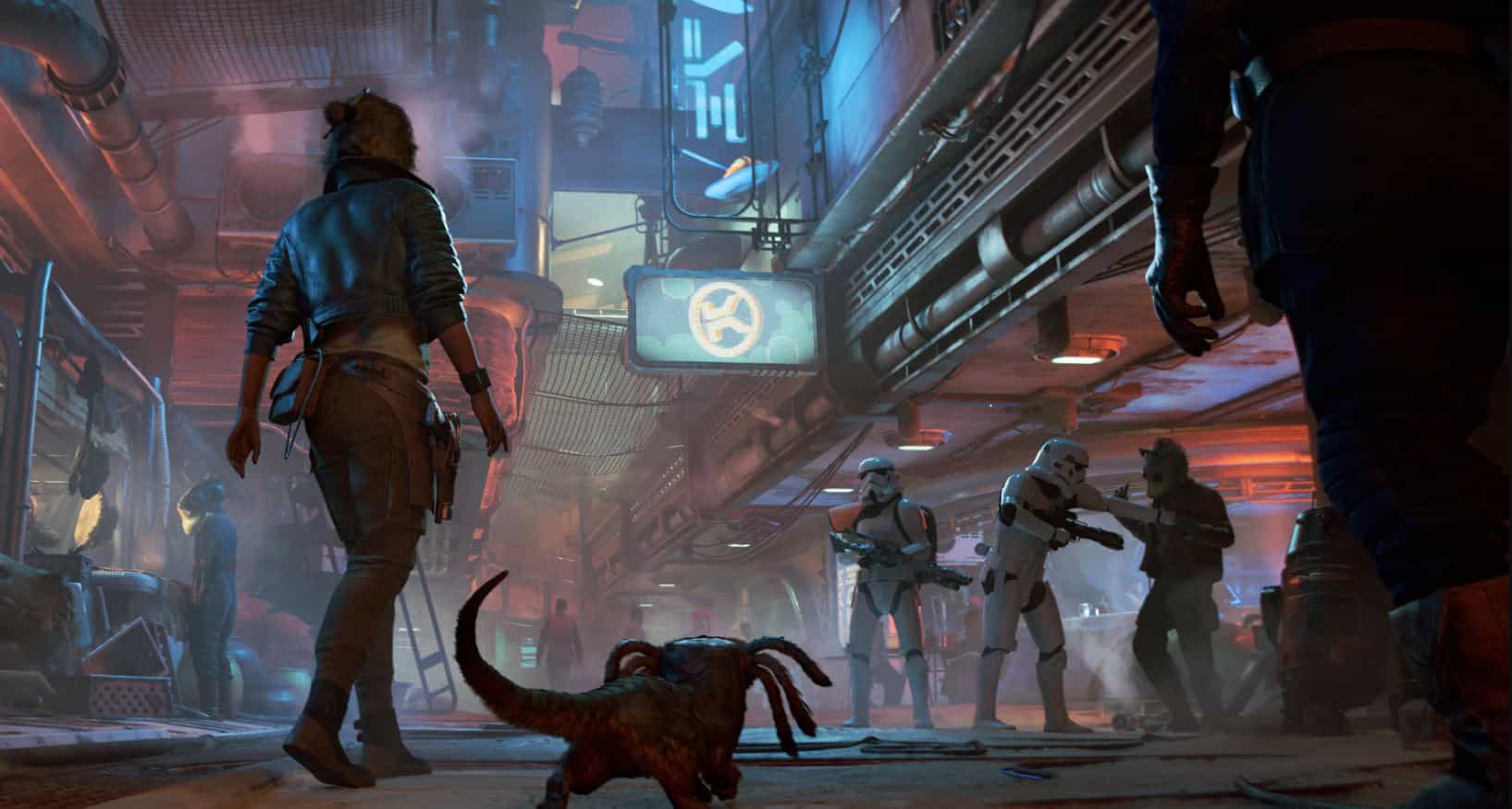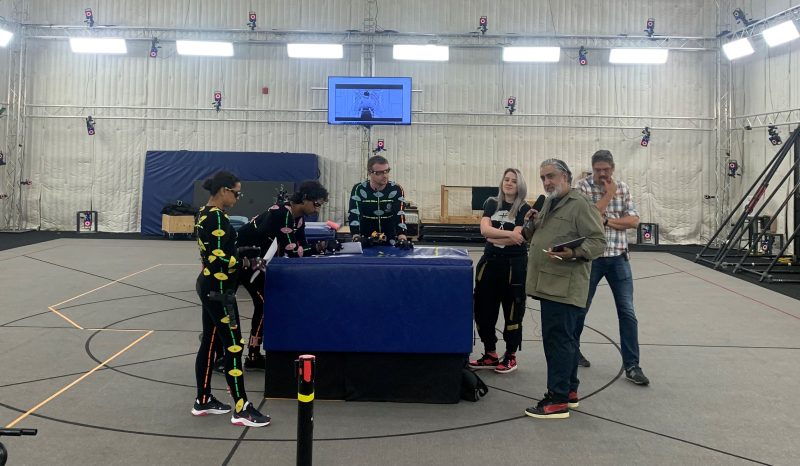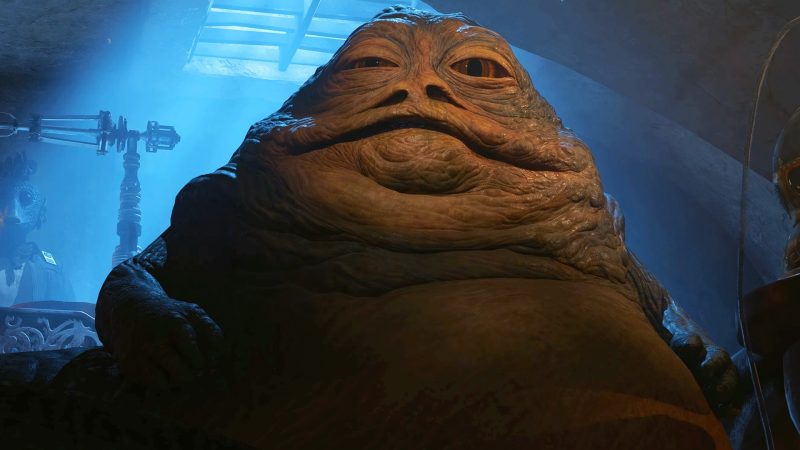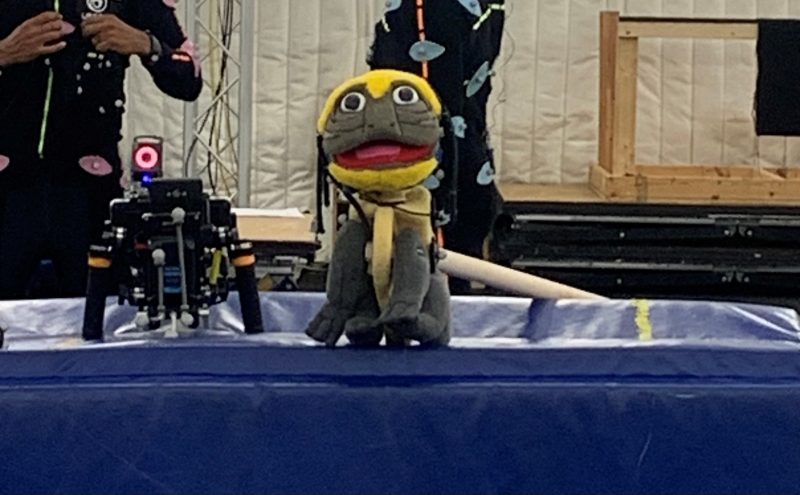With Star Wars: Outlaws only days away from releasing, last week for PSU I got to visit the Ubisoft Toronto studio and get a full behind-the-scenes look at the game, hear from some of the developers behind the game and check out the on-site motion capture studio.
On top of all that I got to speak directly to members of the development team and ask them my own burning questions, and get just a little more insight ahead of the release of Outlaws set for the end of the month.
Unfortunately we weren’t given too long for these interviews, so I was only able to get a few questions in with each session. Since they’re shorter, I’ve put them together in this article.
First, you’ll hear what cinematic and realization director Bogdan Draghici, cinematic animation director Michael Hollenbeck and assistant realization director Jason Cook had to say about Outlaws and their work on it.
Second, you’ll hear from lead scriptwriter Nikki Foy and lead actor Humberly Gonzalez on their own roles regarding Outlaws.
You might be wondering though, that getting to visit the studio and see the motion-capture studio is worth writing a bit about – and you’d be right. That’s why you can find everything about the motion capture studio and what it was like to be at Ubisoft Toronto in my other article, here.
Building A Scoundrel’s Story – Speaking To The Cinematic Team, Writers, And Cast Behind Star Wars: Outlaws
Interview with Bogdan Draghici, Jason Cook & Michael Hollenbeck
PSU: When it comes to creating a scene in Star Wars, what are the core visual elements you believe must be present to make a good Star Wars scene?
Jason Cook: I can start – because of the time period that we’ve placed our game, between Episodes 5-6, we know the cinematography style, the editing style, the camera angles, the pacing and all that kind of stuff that comes from those movies.
And that’s what we start from, that’s what we try to emulate, in everything that we do. So that effects the blocking, the editing of the scene, because we don’t want to bring too modern a sensibility with that. We want to make sure we ground ourselves within that time period. So that’s one of the main things we consider when entering a scene.
Michael Hollenbeck: For me I would say for animation it’s emotion. You want to feel the emotion of the scene, and if you can feel it, then that’s a great foundation for the scene.
Bogdan Draghici: I have a personal opinion on this, and it’s the fact that except designs, or animation characteristics that are recognizable, it’s all about the story. There is no Star Wars directing style – I presented earlier today – each director has their own style that supports the story they’re creating.
It’s funny, because when we had this discussion a couple of times with Lucasfilm, and when we talked with John Knoll I threw him a curve ball and asked him the same thing, ‘what defines the style of Star Wars?’ and his answer was that there’s no specific style.
There are very recognizable designs, there’s a world that has been built up and maintained that propagates throughout the movies and other projects, but the story is the most important. That needs to be supported, and the choice of lenses, the choice of tools, it’s all meant to support that story.
PSU: While there’s no one specific directing style to Star Wars, there are as we’ve pointed out iconic images and very recognizable shots that are scene across all Star Wars. Even in today’s presentation for example, that shot of some kind of animal on a planet surface watching a ship crash land. I feel like that’s the kind of shot you see across all Star Wars. What was the one thing you were so excited to create in your own way that fits into that category of ‘iconic’ shots?
BD: Well actually, I have one sequence that I cannot reveal, but I guarantee when you play the game you’ll know what I’m talking about.
We reveal a character and you’ll see what I mean. I’m just so proud that we can be up there with similar reveals in Star Wars lore. I know I’m being very evasive right now, but trust me – when you play the game you’ll know exactly what I’m talking about.
JC: I think entering into hyperspace from the cockpit is definitely one of the most iconic things, and to see it from the cockpit of our own ship, our own Trailblazer with our own characters is really, really exciting.
That never gets old for me – it’s one of my favourite things.
MH: The Rancor intro, and the different types of camera language and cinematography language used on the original, just trying to do justice to the memory of how you watched that in the film.
So when you encounter it in the game, you get that same kind of experience and feeling.
PSU: What’s the one thing you’re really excited for players to experience in Star Wars: Outlaws?
JC: I think the fact that it’s the first open-world single-player action-adventure game in this universe is so awesome.
The fact that you can go anywhere. And as we showed in our presentation the seamless transition from the surface to space, it’s never been seen before in Star Wars, let alone a Star Wars game.
So it’s a really cool opportunity to live out that scoundrel fantasy.
BD: For me I’ve always been attracted by the ‘becoming’ story of a character. So the story of Kay, and how the story starts, how it ends and to see her trajectory, I hope the players are going to feel the same excitement we felt when making it.
MH: I’m partial to the animation of course, but I think the game itself is fantastic. I just think playing as Kay, traversing the landscape, getting into combat, the transitions from objectives and the items they can find, I think those are all just fantastic and I’m really excited for players to play that, feel it and discover it for themselves.
Interview with Nikki Foy & Humberly Gonzalez
PSU: Nikki, as a scriptwriter, when you sit down to write this grand Star Wars story, what for you are the fundamental elements that make a good Star Wars scene?
Nikki Foy: To me – and smarter people have pointed this out – Star Wars is modern day myth. It’s the prototypical heroes journey. It’s very much about ‘friendship’ and ‘doing the right thing’, these really, – what seem like really basic ideas – but really aren’t because a lot of people, creators especially, are afraid to be really sincere in that way.
So as a genre it’s so helpful, because you get to be sincere without it really seeming like it.
To me what makes a good Star Wars scene is that it’s fun, it’s relatable, it’s got heart, it’s exciting. By the end of it you want to be like “Yes!!” or “No!!!”
Highs and lows, and I think this kind of quick, fun, bombastic energy with characters saying words to each other that you don’t know what they mean sometimes.
That to me is like, ‘Yeah I want to hear someone talk about how many parsecs can fly’ or whatever. So, all that together – a soup. That’s what makes it a soup. *laughs*
PSU: Humberly, I know you went to National Theatre School as part of your training, and from what I know with my time in the theatre world that a lot of the training can be dramatic improv, which I’m sure you did a lot of at NTS. When talking about motion-capture today, you talked about having to imagine everything around you, so do you feel like that training gave you an advantage in mo-cap work?
Humberly Gonzalez: I have no doubt that it infused it. I think the irony of it all is I discovered motion capture while I was at NTS, because in my final year NTS had a collaboration with Ubisoft Montreal and the actors got to do mock scenes from a video game.
We got to wear in the suits and be in the volume – and I had no idea this was a world that existed. But ever since that day I knew I wanted to do video games. So when I graduated and moved to Toronto to pursue this beautiful career where I had no idea what it would be, it was one of the first things I told my agent, that I wanted to work in video games.
Because I felt like it [motion capture] was breathing life into your entire body, you needed an awareness of your entire instrument, and it’s something that I had quite literally be crafting for years in a theatre school.
Whether you’re doing animal work or mask work or clown, whatever it is. I think there’s such an awareness to my body [that I have] that when actors who are classically trained come to this work, there’s an instinctual trusting of what you bring to the table.
And that’s something you can go to school for and posses, and I think motion capture is a beautiful mix of TV, film and theatre.
But yeah, the imagination. The imagining of the world and trusting of the vision is critical, to do video games, because if you can’t believe what’s in front of you, and if you can’t see it, then the camera picks it up, and the story loses the depth that you’re trying to convey.
Absolutely I think my classical training in theatre prepared me for this, which is why I love video games so much. I feel like I’m in a way doing theatre, because you’re playing out the scene full-out. I love mo-cap so much.
PSU: So Humberly I do have to ask about the strike, could you give me your thoughts on the SAG-AFTRA strike?
HG: Strikes come with a very valid reason. Actors need to be protected, especially with the rise of A.I. I would like to do this job for years to come, I don’t want the stories to be told by a machine.
I want there to be a person with experience, with cultural roots, with a background, with a different language, a different upbringing. That will always make characters more complex and interesting. For me it’s very important that we protect that, that we continue to have more representation in that.
I think there’s room for technology to exist and enhance an experience but not completely take over. So anytime there’s a strike and a fight for something better, I hope for the best. That’s my stance on it.
PSU: Keeping with A.I., to you Nikki, I know Ubisoft has not been quiet about its experimentation with A.I. with things like its Neo NPC Project that debuted at GDC, and recently a report from Wired spoke on how certain companies are already forcing their developers to use A.I. In your work, do you feel like A.I. can be helpful, and have you been told to start using it?
NF: I have absolutely not been told to use it in my work at all. I don’t have a ton of visibility on the other stuff that the company might be doing, but for us on Outlaws, no.
We really write from our hearts, and we try to bring as much empathy as possible no matter how big or small a scene seems. For writing a cinematic, there’s a lot of discussion about ‘how did you feel in this moment,’ but honestly we have the same discussions in our writing room over two Stormtroopers talking as they walk down the hallway.
Having a room full of people that all care so much is just so valuable, everyone is just trying to put pieces of themselves in it and it’s all just care, dedication and hardwork from our writing team and everyone really. I’m super happy that we get to tell our stories like this.
PSU: Who is the one Star Wars character that you want Kay Vess to meet?
HG: I mean, I do get to meet Jabba, and that was iconic. I mean, Han Solo but he’s in carbonite *laughs*
Like if Kay and Luke Skywalker were ever going to be in a scene, how epic that would be. Or Princess Leia, or other iconic female characters that I’d just want her to be inspired by, take stock of what they’re doing in the world. Any female protagonist that is in the world, I’ll take it – like Rey, can you imagine?
Just, very cool interactions, to see-
NF: ‘Old Kay’ *laughs*
HG: Like an Old Kay! What happens when she grows up, who is she going to meet? I’d love to see her interact with other female protagonists in the galaxy.
PSU: For you Nikki, you’ve talked a lot today about how you were so excited to work on Star Wars, it’s this great opportunity but also something you grew up loving. What was the thing you were excited to re-create – or create in your own way, when it comes to working on a Star Wars project?
NF: The thing for me, hands-down was Kay meeting Jabba and not knowing who he was. That was just the first thought I had when I heard about this project, just this young, charming, kind of goofy lady wandering in and being like ‘whatever.’
As a kid [Jabba] was just like the scariest thing I ever saw, and just having Kay not knowing who he was I thought was so fun. I remember early on in the project I wrote like, 20 different scenes of Kay talking to Jabba that we were never going to use just to practice and find her voice. So that was my big moment.
PSU: What would you say is the defining tone of the story in Outlaws?
NF: I think our story is about freedom, and what that looks like for different people. I think the main tone for me is about really taking the things that you want. Kay is dealt a hand of cards that she cannot win, so she cheats – and I love that.
PSU: And one last question for you Humberly – who’s the faster shot, Kay or Han?
HG: You know, Kay might be a rookie but she is reactive – she is not trained but I’m going to say her because she is young and vitality is on her side. *laughs*
Thank you to Bogdan Draghici, Jason Cook, Michael Hollenbeck, Nikki Foy and Humberly Gonzalez for taking the time for these interviews.
